Daimler Double-Six sleeve-valve V12
Daimler Double-Six piston engine was a sleeve-valve V12 engine manufactured by The Daimler Company Limited of Coventry, England between 1926 and 1938 in four different sizes for their flagship cars.
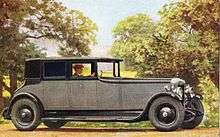
The colossus of roads
transverse section
Daimler required an advanced new model to compete with Rolls-Royce's New Phantom of 1925. Though Packard had introduced its Twin-Six many years earlier it was to be a decade or more before luxury manufacturers like Rolls-Royce, Hispano-Suiza, Lincoln, Voisin and Lagonda made their own (and Packard returned to it). In fact by the mid-1930s flexible engine mountings and improved carburation had made so many cylinders unnecessary. What did return them to a certain level of popularity was the push for higher performance requiring higher crankshaft speeds. Daimler introduced their first 26 hp straight-eight in mid-1934 and their last (poppet valve) V12s were built in 1937 or 1938.[1]
From 1929 Daimler Double-Sixes were distinguishable from the six-cylinder cars by a chromium bar down the centre of the radiator.[2] A similar distinguishing mark was placed on the later Jaguar-made versions.
Aside from Daimler only Voisin in France ever attempted production of a sleeve-valve V12 engine. Voisin's production—between 1929 and 1937—was "minimal and spasmodic".[3]
The same Daimler Double-Six name was used for the badge-engineered Daimler V12 engine used in the largest Daimlers between 1972 and 1997. Lofty England,[note 1] a Daimler apprentice 1927–1932, joined Jaguar in 1946 and became its chief executive. He ensured the Double-Six name was used for the Jaguar V12 when installed in Daimler cars.[4]
Design
This engine was designed by[5][note 2] consultant Chief Engineer L H Pomeroy (1883-1941) to achieve high power with quietness and, particularly, smoothness. Pomeroy made the engine by taking the cylinder blocks of two existing 25/85 hp Daimler engines and putting them on a common crankcase. Pomeroy was to be appointed managing director in 1929.[1] The same design was produced in different sizes depending on the different engine displacements.
7.1-litre Double-Six 50
| Daimler Double-Six (50) | |
|---|---|
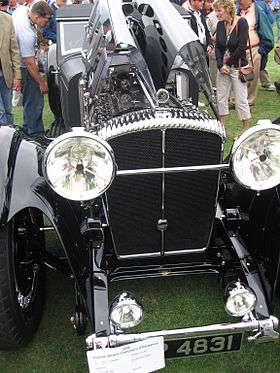 | |
| Overview | |
| Manufacturer | The Daimler Company Limited |
| Also called | Daimler Double-Six |
| Production | 1926-1930 |
| Combustion chamber | |
| Configuration | 60 degree V twelve-cylinder |
| Displacement | 7.136 litres (435 cu in) |
| Cylinder bore | 81.5 mm (3.2 in) |
| Piston stroke | 114 mm (4.5 in) |
| Cylinder block alloy |
Cast iron, cast in blocks of 3 cylinders Alloy pistons running in light steel sleeve-valves |
| Cylinder head alloy | Cast iron? detachable, separate head for each block |
| Valvetrain | Sleeve-valves, double light steel sleeves operated by pushrod from chain-driven eccentric shafts in the engine block |
| Combustion | |
| Fuel system | Twin 7-jet Daimler carburettors with pre-heated air supply, petrol supplied by mechanical pump mounted near the carburettor. Ignition by two magnetos and battery and coil |
| Fuel type | Petrol |
| Oil system | Submerged pump, separate radiator |
| Cooling system | Water: belt-driven four-blade fan and radiator |
| Output | |
| Power output | 150 bhp (110 kW; 150 PS) @ 2,480 rpm |
| Chronology | |
| Predecessor | 57 hp inline six-cylinder |
| Successor | Double-Six 40/50 |
Engine
Announced 15 October 1926 and observed by The Observer's motoring correspondent to be Britain's first twelve-cylinder car engine.
- Bore and stroke 81.5 mm x 114 mm gave a swept volume of
- 7136 cc
Power output 150 bhp (110 kW; 150 PS) @ 2480 rpm.
Tax rating 50 hp
- Cylinders arranged in blocks of three
- Pistons were of light alloy and split-skirted "like the modern girl"
- Double light steel sleeves controlled the inlet of fuel and the outlet of exhaust, they were operated by short connecting rods from their eccentric-shafts
- Separately detachable cylinder heads
- 60 degree angle V
- Crankcase aluminium
- The big-ends lay in pairs, the right-hand ones forked so that diagonal pairs of cylinders were in the same plane
- Connecting rods were H-section
- Crankshaft ran in seven bearings and had an external Lanchester-type vibration damper at the front
- Two sleeve-operating eccentric-shafts were driven by chain at the rear of the engine each ran in four bearings
- Daimler seven-jet carburettor, water-pump, magneto, exhaust pipe and silencer were duplicated, each block of cylinders having its own components
- Petrol was supplied to a reservoir by the engine from the rear-mounted tank by air pressure
- Each Daimler carburettor had an independent pre-heated air supply and four jets plus a primer which acted as a pilot with a separate air supply
- Inlet manifolds were water-heated and mounted on the outside of each cylinder block
- With the primer lubricant was passed to the cylinders and with the depression of the starter pedal oil delivered to the lower end of the sleeves
- Oil was forced to the main and big-end bearings, the sleeve-shafts and the sleeves
- Oil was cooled through a radiator
_(1280x853).jpg)
"His 35/120 hp cars were nothing like worn out, so instead of ordering the new model the King had "Double-Six" engines installed in his existing Daimlers. However, by the end of 1927 His Majesty had taken delivery of a complete V12 model"[1]
- 6a 5a 4a 3a 2a 1a
- 1b 2b 3b 4b 5b 6b
- order of firing: 1b 1a, 5b 5a, 3b 3a, 6b 6a, 2b 2a, 4b 4a
- Dual ignition was fitted
- Distributors were coupled as were all the change-over switches from the coil to magneto ignition
- Magnetos and water pumps were driven through transverse shafts by skew gearing from the nose of the crankshaft
- Dynamo operated by silent chain
- Two vertical shafts from the same source drove contact breakers and distributors set above the cylinder banks
- Belt-driven four-bladed radiator fan
- Fuel was pumped from the rear tank by air pressure from a mechanical pump mounted near the carburettor
- The exhaust pipes passed through the V of the cylinder blocks and were covered with an aluminium plate to dissipate heat.
- The engine and clutch were mounted as a unit separately from the gearbox[6]
The result was an engine which idled at 150 rpm and ran with uncanny silence "the only audible sound made by a Double-Six (if you opened the bonnet and went right up to it) was the almost imperceptible tick as the ignition points opened and the faint breathing of the carburettor".[7]
This largest engine faded from the catalogue after 1930[1]
Chassis
- Chassis frame was channel section
- Gearbox: driven through a single dry plate disc clutch mounted on the engine a separate four-speeds and reverse gearbox was mounted on a very substantial cross-member and controlled by a central ball-gate gear lever.
- Hand brake operated shoes in a brake drum mounted at the back of the gearbox
- Power was taken by open propeller-shaft with metal universal joints to a (virtually silent) underslung worm-drive to the rear axle
- Suspension was by gaitered half-elliptic leaf springs - beneath the axle at the back
- Brakes on four wheels were rod-operated with assistance from a Dewandre vacuum servo positioned beside the gearbox. Adjustment could be made by hand
- Steering: the width of the engine necessitated mounting the worm and sector reduction box on the scuttle. From there a coupling lever dropped to a bell-crank pivoted on the chassis side-member. A normal drag-link ran to the front axle.
- Wheelbase:
- Type O wheelbase 155.5 in (3,950 mm) Track 60.0 in (1,524 mm)
- Type P wheelbase 163.0 in (4,140 mm) Track 60.0 in (1,524 mm)
- Type W wheelbase 155.5 in (3,950 mm) Track 57.0 in (1,448 mm)
- Tyres:
- 7.3 in (185 mm) x 37 in (940 mm) or
- 6.75 in (171 mm) x 33 in (838 mm) or
- 6.75 in (171 mm) x 35 in (889 mm)
- Dimensions of standard saloon de luxe:
- Length 223 in (5,664 mm)
- Width 76 in (1,930 mm)
- Height 82 in (2,083 mm)
Prices
- Chassis prices: Type O £1,850, Type P £1,950, Type W £1,950
- Standard saloon de luxe by Daimler £2,450
- Standard enclosed limousine by Daimler £2,800[1]
3.7-litre Double-Six 30
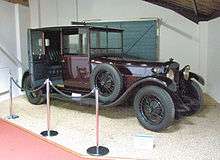
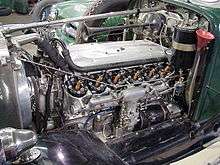
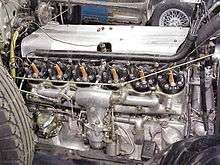
Announced 1 August 1927. Formed around a pair of 16/55 cylinder blocks[1]
- Bore and stroke 65 mm x 94 mm gave a swept volume of
- 3744 cc
Power output 100 bhp (75 kW; 100 PS),
Tax rating 31.4 hp[8]
Design change
- Wheelbase:
- Type Q wheelbase 131 in (3,327 mm) Track 52.0 in (1,321 mm)
- Type M wheelbase 141.0 in (3,581 mm) Track 52.0 in (1,321 mm)
- Type V wheelbase 142.0 in (3,607 mm) Track 54.0 in (1,372 mm)
- Type O wheelbase 145.0 in (3,683 mm) Track 60.0 in (1,524 mm)
- Tyres:
- 5.25 in (133 mm) x 31 in (787 mm) on the coupé tested by The Times[8]
- Dimensions of standard saloon:
- Length 190 in (4,826 mm)
- Width 65 in (1,651 mm)
- Height 72 in (1,829 mm)
Prices
- Chassis prices:
- Standard saloon by Daimler £1.300
Production ended in 1932, none with fluid flywheel and pre-selector gearbox.[1]
5.3-litre Double-Six 30/40 or Light Double-Six
Announced October 1930 and matched with the new Daimler fluid flywheel and Wilson pre-selective half-automatically changing four-speed gearbox.
- Bore and stroke 73 mm x 104 mm gave a swept volume of
- 5296 cc[10]
Tax rating 40.18 hp[11]
In November 1930 a car was shipped to Edsel Ford with the new Daimler transmission. It aroused so much interest Cadillac's chief engineer, Ernest Seaholm, came to the following Olympia show and bought another for technical investigation. It inspired Earl Thompson, who invented syncromesh, to develop the Hydramatic transmission.[12]
This light double-six was one of the first cars designed using ergonomics. Switches buttons and stalks were all placed within finger tip reach of the driver and accessible without taking hands from the wheel. The cars would run up to 40,000 miles (64,000 km) before requiring engine decarbonisation.[13]
Design changes
Engine
- Cylinder block a one-piece light alloy casting[14]
- Distributors were moved to the back of the engine
- Cover plates provided in the crankcase which could be removed to reveal the sleeve-eccentric links
- Carburettors moved forward
- Lubrication by two submerged helical-gear pumps, one feeding all moving parts, the other circulating oil through the oil radiator[1]
- Oil radiator to maintain a constant 130 °F (54 °C)[14]
- Cold viscid oil forced open valves allowing oil into troughs below the big-ends to provide cold-start splash lubrication of the sleeves[14]
- Hand-operated oil cleaner
- Water pumps on outside of each cylinder bank mounted in tandem with dynamos
This model was usually supplied with a taller and more slender radiator.
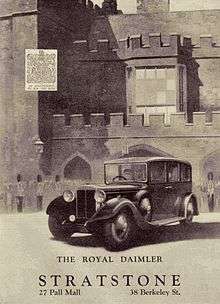
for King George V
Chassis
- Grouped chassis lubrication
- Back axle incorporating dip-stick cum oiling syringe
- Hydraulic shock absorbers
- Wheelbase:
- Short wheelbase 138 in (3,505 mm) Track 60.0 in (1,524 mm)
- Medium wheelbase 147.5 in (3,746 mm) Track 60.0 in (1,524 mm)
- Long wheelbase 157.0 in (3,988 mm) Track 60.0 in (1,524 mm)
Prices
- Chassis prices: Short £1,100, Medium £1,200, Long £1,350
- Short wheelbase standard saloon by Daimler from £1,600
- Medium wheelbase limousine by Daimler from £1,900
- Long wheelbase limousine by Daimler from £2,300[1]
6.5-litre Double-Six 40/50
Announced October 1930 and matched with the new Daimler Fluid Flywheel and Wilson pre-selective half-automatically changing four-speed gearbox.
- Bore and stroke 81.5 mm x 104 mm gave a swept volume of
- 6511 cc[10]
Tax rating 49.4 hp[11]
Cylinder block a one-piece light alloy casting[15]
Double-Six 40/50 with poppet valves
From 1935 to 1938 nine[16] Double-Six 40/50 engines were made with poppet valves - possibly to use surplus components.[1]
Performance
The Autocar reported in April 1927 the big cars needed no other gears once they were rolling, even climbing a hill. Petrol consumption was not so savage as might have been expected at 10 miles per gallon. "2 to 82 mph in top gear in the highest degree of smoothness and quietness" said The Autocar ". . . fortunate beings will leisurely survey the moving surface of the earth through the windows of their Daimler Double-Sixes as they pass onward in silent dignity".[1]
A letter from Tony Bird in the January 1967 issue of Motor Sport recounted how Double-Six models could develop violent front axle "wheel wobble" which could only be overcome by stopping the car.
Bodies
Bodies were all mounted after the Daimler pattern on a separate frame flexibly held.
Presence
A contemporary press report remarked that "when the Double-Six arrives at the door there is no obvious pomp and circumstance. Here is a car that looks clean-cut and aristocratic in its speckless grey paintwork. It is not until one comes close to the car that its great size is realised. The Daimler bonnet is nearly level with the chin of the observer." Autocar[17][18]
Difficulties
William Boddy of Motor Sport commented that the difficulty with sleeve valves was lubrication. So much oil near the combustion chambers led to a gummy engine prone to seize if left standing for any length of time. Attempts to tow-start invariably led to sleeve-driving link breakage if not damage to the sleeves. There was also difficulty in timing the sleeves once pistons had been out of the block and also synchronising carburation and ignition between the two banks of cylinders.[1][19]
Daimler introduced their new Straight-Eight in 1934 and Double-Sixes slipped slowly from the catalogue.[1]
Notes
Footnotes
- ↑ F R W England and J Mercer drove a Double-Six to second place (to a 15/18 Lanchester) in the 1932 RAC Rally (Douglas-Scott-Montagu & Burgess-Wise 1995, pp. 220, 221)
- ↑ This information may relate to the second series 30/40 and 40/50 engines with alloy blocks. Pomeroy was in the United States until October 1926 (Douglas-Scott-Montagu & Burgess-Wise 1995, p. 199) and, it appears, could not have designed the first series, which was exhibited to the public that month.
Citations
- 1 2 3 4 5 6 7 8 9 10 11 12 13 Boddy 1966, p.
- ↑ Smith 1972, pp. 63, 68.
- ↑ Douglas-Scott-Montagu & Burgess-Wise 1995, p. 205.
- ↑ Jonathan Wood, Obituaries: LOFTY ENGLAND The Independent Friday, 9 June 1995
- ↑ Smith 1972, p. 60.
- ↑ The New Daimler. by Our Motoring Correspondent, The Times, Friday, Oct 15, 1926; pg. 12; Issue 44403.
- ↑ Douglas-Scott-Montagu & Burgess-Wise 1995, p. 200.
- 1 2 Cars Of To-Day.The Times, Tuesday, Mar 06, 1928; pg. 22; Issue 44834
- ↑ Daimlers For 1928. (from Our Motoring Correspondent) The Times, Monday, Aug 01, 1927; pg. 7; Issue 44648
- 1 2 The Olympia Show. by Our Motoring Correspondent, The Times, Thursday, Oct 23, 1930; pg. 8; Issue 45651
- 1 2 New Royal Cars.The Times, Friday, Apr 17, 1931; pg. 12; Issue 45799.
- ↑ Douglas-Scott-Montagu & Burgess-Wise 1995, p. 208.
- ↑ Douglas-Scott-Montagu & Burgess-Wise 1995, p. 207.
- 1 2 3 Douglas-Scott-Montagu & Burgess-Wise 1995, p. 206.
- ↑ Douglas-Scott-Montagu & Burgess-Wise 1995, p. 209.
- ↑ Douglas-Scott-Montagu & Burgess-Wise 1995, p. 228.
- ↑ Smith 1972, p. 62.
- ↑ Smith, Brian E. (1980). The Daimler Tradition. Isleworth UK: Transport Bookman. p. . ISBN 085184 014 0.
- ↑ William Boddy (1961). "Daimler During The Vintage Years". Motor Sport (June, 1961): 479.
References
- Boddy, William (1966). The Daimler Double-Sixes. No 40 Leatherhead: Profile Publications.
- Douglas-Scott-Montagu, Edward John Barrington & Burgess-Wise, David (1995). Daimler Century: The full history of Britain's oldest car maker. Sparkford, Nr Yeovil, Somerset, UK: Patrick Stephens. ISBN 1 85260 494 8.
- Smith, Brian E. (1972). The Daimler Tradition. Isleworth, UK: Transport Bookman. ISBN 0851840043.
External links
| Wikimedia Commons has media related to Daimler double-six 1926-1934. |
Images not otherwise available
YouTube
| « previous — Daimler road car timeline, 1920–1940* — next » | |||||||||||||||||||||
|---|---|---|---|---|---|---|---|---|---|---|---|---|---|---|---|---|---|---|---|---|---|
| Tax hp range | 1920s | 1930s | |||||||||||||||||||
| 0 | 1 | 2 | 3 | 4 | 5 | 6 | 7 | 8 | 9 | 0 | 1 | 2 | 3 | 4 | 5 | 6 | 7 | 8 | 9/0 | ||
| Less than 15 | 12 | ||||||||||||||||||||
| 15–19 | 16 | 16 or 16/55 | 15 | 15 | New 15 | New 15 | |||||||||||||||
| 20–24 | 20 (4-cyl.) | 20/70 or 20 or 16/20 | 20 | Light 20 or 20 | |||||||||||||||||
| 21 | 20 or Six or 24 | ||||||||||||||||||||
| 25–29 | 25/85 or 25 or 24.7 or 20/25 | 25 (8-cyl.) | Light Straight-Eight | 4 L | |||||||||||||||||
| 30–34 | 30 | Double-Six 30 or 31.4 | Straight-Eight | ||||||||||||||||||
| 35–39 | 35/120 or 35 | ||||||||||||||||||||
| 40–44 | Double-Six 30/40 or 40 | ||||||||||||||||||||
| 45 or more | 45 | Double-Six 50 | Double-Six 40/50 or 50 | Double-Six | |||||||||||||||||
| 45 | |||||||||||||||||||||
| |||||||||||||||||||||